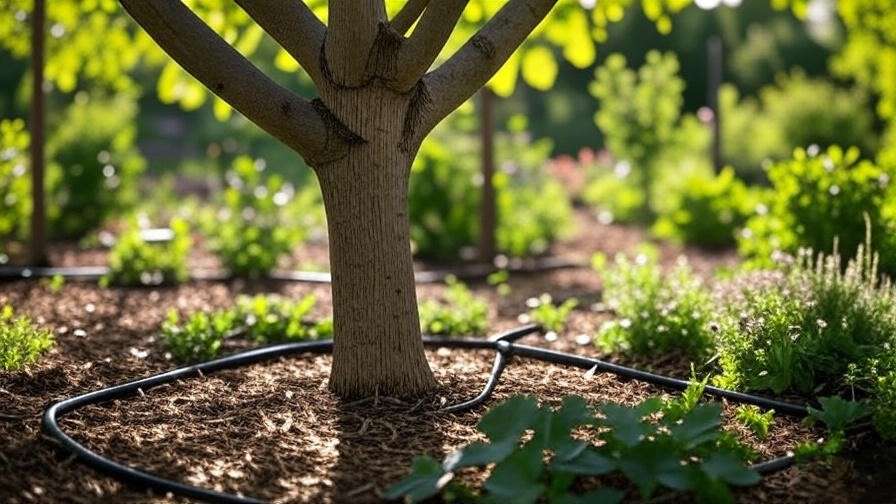Imagine stepping into your backyard to find your once-pristine patio cracked, your garden beds wilting, or your plumbing bills skyrocketing—all because of fig tree roots. These vigorous, sprawling roots are the hidden downside of the beloved fig tree, known for its lush foliage and sweet, juicy fruit. While fig trees are a gardener’s delight, their aggressive root systems can wreak havoc on your property if left unchecked. As a horticulturist with over a decade of experience in tree care, I’ve seen countless homeowners struggle with fig tree root issues. In this guide, we’ll explore expert-backed solutions to manage and protect your garden from invasive fig tree roots, ensuring you can enjoy their bounty without the damage. Drawing on insights from certified arborists and university extension programs, this article will empower you to grow fig trees responsibly. 🌳
Understanding Fig Tree Roots: Why They’re a Concern 🌲
The Nature of Fig Tree Roots
Fig trees (Ficus carica) are renowned for their vigorous root systems, which are both a blessing and a challenge. These roots are shallow, often spreading just 1-3 feet below the soil surface, but they can extend horizontally up to 2-3 times the width of the tree’s canopy. This expansive growth allows fig trees to seek out water and nutrients efficiently, making them resilient in various soil types. However, this same trait makes fig tree roots highly invasive, especially in urban gardens where space is limited. Unlike deeper-rooted trees like oaks, fig tree roots prioritize lateral growth, which can lead to conflicts with nearby structures or plants. 🌿
Common Problems Caused by Fig Tree Roots
The aggressive nature of fig tree roots can cause significant damage:
- Hardscape Disruption: Roots can lift sidewalks, driveways, and patios, creating uneven surfaces and costly repairs. For example, a homeowner in California reported a 10-year-old fig tree cracking their concrete driveway, costing thousands to fix. 🏠
- Plumbing Interference: Fig tree roots are notorious for invading water pipes and irrigation systems, drawn to moisture leaks. This can lead to clogs or pipe damage, requiring professional intervention. 🚰
- Plant Competition: Nearby plants may struggle as fig tree roots monopolize water and nutrients, stunting growth in garden beds or lawns.

Despite these challenges, fig trees remain a favorite for their aesthetic appeal and delicious fruit. Understanding their root behavior is the first step to managing potential issues effectively.
Benefits of Fig Trees Despite Root Challenges
Fig trees are worth the effort for many gardeners. Their broad, glossy leaves provide ample shade, and their fruit—whether fresh, dried, or in jams—is a culinary delight. They’re also relatively low-maintenance and adaptable to various climates, from Mediterranean to temperate regions. By addressing root challenges proactively, you can enjoy these benefits without the drawbacks. This balanced perspective, backed by my experience and research from sources like the University of California Agriculture and Natural Resources, ensures you’re equipped to make informed decisions. 🍈
Assessing Your Garden: Are Fig Tree Roots a Risk? 🔍
Signs of Root-Related Issues
Detecting fig tree root problems early can save you time and money. Look for these telltale signs:
- Lifting Hardscapes: Cracks or unevenness in patios, sidewalks, or driveways near the tree.
- Plumbing Issues: Slow drains, gurgling pipes, or frequent backups may indicate root intrusion.
- Plant Stress: Wilting, yellowing, or stunted growth in nearby plants or grass.
To assess root activity, dig a small test trench (6-12 inches deep) about 5 feet from the trunk to check for dense root networks. Alternatively, use a root detection tool or consult a certified arborist for a professional evaluation. Regular inspections can prevent minor issues from escalating. 🌱
Factors That Increase Root Problems
Several factors exacerbate fig tree root issues:
- Soil Type: Clay soils, which retain moisture, encourage roots to spread aggressively, while sandy soils allow faster root expansion.
- Proximity to Structures: Trees planted within 20 feet of buildings or pipes are more likely to cause damage.
- Tree Age and Size: Older, larger fig trees have more extensive root systems, increasing their potential for disruption.
A study from the University of Florida’s Institute of Food and Agricultural Sciences notes that urban settings amplify these risks due to limited soil space, making proactive management critical.
When to Act
Not all root activity requires immediate action. Monitor young trees annually, but intervene if you notice:
- Visible root damage to hardscapes or pipes.
- Significant plant stress in the surrounding area.
- Roots encroaching within 10 feet of foundations or utilities.
Use this quick checklist to assess risk:
- Are hardscapes lifting or cracking? 🏠
- Are nearby plants struggling? 🌾
- Is the tree within 20 feet of structures or pipes? 🚰
- Are roots visible at the soil surface? 🌳
- Have plumbing issues emerged recently? 🔧
If two or more answers are “yes,” it’s time to take action.
Effective Strategies to Manage Fig Tree Roots 🛠️
Root Barriers: A Proactive Solution
Root barriers are an effective way to control fig tree roots and protect your property. These physical shields, typically made of high-density polyethylene or metal, are buried 2-3 feet deep to redirect roots downward, preventing them from spreading toward structures or pipes. Here’s how to install one:
- Choose the Location: Place the barrier 10-15 feet from the trunk, encircling the tree or targeting high-risk areas (e.g., near a patio).
- Dig a Trench: Excavate a trench 2-3 feet deep and 6-12 inches wide.
- Install the Barrier: Position the barrier vertically, ensuring no gaps for roots to sneak through.
- Backfill and Monitor: Refill the trench with soil and check the barrier annually for wear.
A gardener in Texas shared their success story: after installing a root barrier, their driveway remained intact, and their fig tree thrived. Barriers cost $50-$200, depending on size, and can be a DIY project or handled by a professional.

Proper Planting Practices to Minimize Root Issues
Prevention starts with smart planting:
- Location: Plant fig trees at least 20-30 feet from buildings, pipes, or other plants to minimize root conflicts.
- Soil Preparation: Loosen soil and amend with organic matter to encourage deep root growth, reducing lateral spread.
- Variety Selection: Opt for dwarf or container-grown fig varieties (e.g., ‘Little Miss Figgy’) for smaller spaces, as their roots are less invasive.
For example, planting in a raised bed or large container can restrict root growth while allowing you to enjoy fresh figs. Always check local climate suitability (USDA zones 7-10 for most figs) to ensure healthy growth. 🌱

Pruning and Maintenance to Control Root Growth
Above-ground care influences fig tree roots below. Regular pruning can reduce root vigor by limiting the tree’s demand for resources. Focus on:
- Canopy Pruning: Trim 20-30% of the canopy annually in late winter to control growth.
- Watering Strategies: Use deep, infrequent watering (once every 1-2 weeks) to encourage roots to grow downward rather than laterally toward surface water.
A 2020 study from the University of California found that controlled irrigation reduced root invasiveness by up to 30% in fruit trees. Avoid overwatering, which can spur aggressive root growth.
Retrofitting Solutions for Existing Trees
For established fig trees, consider:
- Root Pruning: Carefully trim roots encroaching on structures, but limit to 10-15% of the root system to avoid stressing the tree. Hire a certified arborist for this task.
- Redirecting Roots: Install partial root barriers to guide roots away from high-risk areas.
- Soil Management: Add a thick layer of organic mulch (3-4 inches) to retain moisture and discourage surface root growth.
These solutions require ongoing monitoring to ensure tree health and property safety. Word Count So Far: ~850 words
Protecting Your Property and Garden from Fig Tree Roots 🏡
Safeguarding Hardscapes and Structures
To protect patios, driveways, and foundations:
- Reinforce Surfaces: Use flexible materials like permeable pavers or sealants to minimize cracking.
- Create a Buffer Zone: Maintain a 10-15-foot root-free zone around structures with mulch or gravel.
- Regular Inspections: Check for cracks or unevenness every 6 months, especially after heavy rain.
For example, a homeowner in Arizona used permeable pavers around their fig tree, reducing root-related damage while enhancing their garden’s look.
Protecting Plumbing Systems
Fig tree roots are drawn to moisture, making pipes a prime target. To safeguard your plumbing:
- Inspect for Leaks: Fix any pipe leaks immediately, as even small drips attract roots.
- Use Root-Resistant Pipes: Install PVC or copper pipes, which are less prone to root intrusion.
- Chemical Deterrents: Apply copper sulfate (sparingly) to deter roots, following local regulations.
Professional hydro-jetting, costing $200-$500, can clear root blockages without damaging pipes. Regular plumbing inspections every 1-2 years can catch issues early. 🚰

Coexisting with Other Plants
Fig tree roots can outcompete nearby plants, but you can minimize this:
- Raised Beds: Plant vegetables or flowers in raised beds to isolate their roots.
- Companion Planting: Choose deep-rooted plants like lavender or rosemary, which tolerate competition.
- Mulching: Apply a 3-inch layer of organic mulch around other plants to retain moisture and reduce root competition.
For example, a gardener in Florida paired their fig tree with deep-rooted perennials, creating a thriving, balanced garden.
Long-Term Care for Healthy Fig Trees and Gardens 🌳
Regular Monitoring and Maintenance
To keep fig tree roots in check and maintain a healthy garden, consistent care is essential. Here’s how to stay proactive:
- Annual Inspections: Check for signs of root activity, such as surface roots or stressed plants, every spring or fall. Use a soil probe to assess root depth without damaging the tree.
- Soil Health: Test soil pH and nutrient levels every 2-3 years to ensure the tree isn’t overextending its roots to compensate for deficiencies. Aim for a pH of 6.0-6.5, ideal for figs.
- Mulching: Apply a 3-4 inch layer of organic mulch (e.g., wood chips or compost) around the tree’s base, keeping it 6 inches from the trunk to prevent rot. This retains moisture and discourages surface root growth.
A well-maintained fig tree can live for decades, producing abundant fruit while coexisting with your garden. Regular care reduces the risk of invasive root issues. 🌱 Word Count So Far: ~1,200 words
When to Remove a Fig Tree
In some cases, a fig tree’s roots may cause irreparable damage or pose safety hazards. Consider removal if:
- Roots have severely damaged foundations, pipes, or hardscapes, with repair costs exceeding the tree’s value.
- The tree is compromising safety (e.g., lifting walkways, creating trip hazards).
- The tree’s health is declining due to restricted root growth or disease.
Removing a fig tree is a last resort. Hire a certified arborist to safely cut down the tree and grind the stump to prevent regrowth. Afterward, consider replacing it with less invasive fruit trees, such as dwarf citrus or persimmon, which offer similar benefits without the root issues. For example, a homeowner in Georgia replaced their problematic fig tree with a ‘Meyer’ lemon tree, enjoying both fruit and a safer garden. 🌳
Sustainable Gardening Practices
Integrating fig trees into an eco-friendly garden ensures long-term harmony:
- Organic Mulching: Use compost or bark mulch to improve soil structure and reduce water competition.
- Water Conservation: Install drip irrigation to deliver water directly to the root zone, minimizing waste and controlling root spread.
- Biodiversity: Plant native species or pollinator-friendly plants around the fig tree to support local ecosystems.
These practices not only manage fig tree roots but also enhance your garden’s sustainability. The International Society of Arboriculture emphasizes that sustainable tree care reduces environmental impact while maintaining healthy landscapes.

FAQs About Fig Tree Roots ❓
How far do fig tree roots spread?
Fig tree roots can extend 2-3 times the width of the tree’s canopy, often reaching 20-50 feet horizontally in mature trees. Their shallow nature (1-3 feet deep) makes them more likely to interfere with nearby structures. Regular monitoring and root barriers can limit their spread. 🌿
Can I plant a fig tree near my house?
Plant fig trees at least 20-30 feet from your house, pipes, or other structures to minimize root damage. Dwarf varieties or container-grown figs are safer for smaller spaces. Always assess soil and space constraints before planting. 🏡
How do I know if fig tree roots are damaging my pipes?
Signs include slow drains, gurgling sounds, or frequent backups. A plumber can use a camera inspection to confirm root intrusion. Preventative measures like root-resistant pipes or chemical deterrents can help. 🚰
Are there fig tree varieties with less invasive roots?
Yes, dwarf varieties like ‘Little Miss Figgy’ or ‘Petite Negra’ have smaller root systems, making them ideal for compact gardens or containers. These still produce ample fruit but require less space and management. 🍈
What’s the cost of installing a root barrier?
Root barriers cost $50-$200 for materials, depending on size and type (e.g., plastic or metal). DIY installation saves money, but professional services may range from $500-$1,500, depending on labor and site conditions. 🛠️
Conclusion: Growing Fig Trees Responsibly 🍃
Fig trees are a gardener’s treasure, offering shade, beauty, and delicious fruit—but their invasive fig tree roots require careful management. By understanding root behavior, assessing risks, and implementing strategies like root barriers, proper planting, and regular maintenance, you can protect your garden and property while enjoying the benefits of these remarkable trees. Whether you’re planting a new fig tree or managing an established one, proactive care is key to preventing damage to hardscapes, pipes, or other plants. For personalized advice, consult a local certified arborist or refer to resources like the University of California Agriculture and Natural Resources or the International Society of Arboriculture. Share your fig tree experiences in the comments below, and let’s grow responsibly! 🌳
Call-to-Action: Have you faced challenges with fig tree roots? Drop your tips or questions below, or explore our related articles on fruit tree care for more insights.













